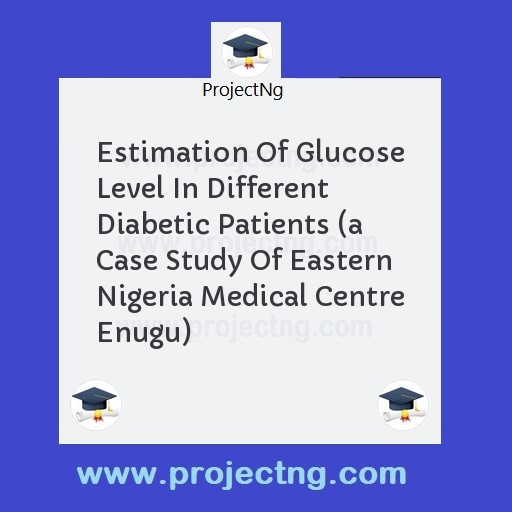Estimation Of Glucose Level In Different Diabetic Patients (a Case Study Of Eastern Nigeria Medical Centre Enugu)
Science Lab Technology Project Topics
Get the Complete Project Materials Now! »
ESTIMATION OF GLUCOSE LEVEL IN DIFFERENT DIABETIC PATIENTS
(A CASE STUDY OF EASTERN NIGERIA MEDICAL CENTRE ENUGU)
ABSTRACT
As its title suggests, this project is geared at presenting the reader with the estimation of glucose level in different diabetic patients, in a sample and in understandable manner. The purpose of this project work is aimed at estimating the glucose level in different diabetic patients, and finding various methods or ways of curing people with diabetes.
Also, knowing its consequences and providing adequate drugs, insulin or treatment for a particular type of diabetes, the glucose level of a diabetic patient might be hyperglycamia or hypoglycemia, that is when the glucose level is either high or low respectively. The normal value for fasting blood sugar is 70-100mgdl while for random blood sugar is 100-130mgtdl.
When a patient is diagnosed for diabetes, if the value is high or low from the normal range that patient is diabetic from the finding, people at the
age bracket of 80 years and above have high rate of diabetes. Also, people within the age bracket of 25-50 years are diabetic, also, while people in the age bracket of 13-25 years have low rate of diabetes.
Enzymetic method, which is the most reliable method, was used to diagnose for the glucose level of the patient.
TABLE OF CONTENTS
Title Page
Approval Page
Dedication
Acknowledgment
Abstract
Table of Content
CHAPTER ONE
1.0 Introduction
1.1 Types of diabetes
1.2 Terms used to describe collection of blood glucose level
1.3 Interpretation of blood glucose result
1.4 Statement of problem
1.5 Aim and objective
1.6 Significance of study
1.7 Hypothesis
1.8 Limitation
CHAPTER TWO
2.0 Literature review
CHAPTER THREE
3.0 Materials and methodology
3.1 Area of study
3.2 Material and apparatus
3.3 Principle
3.4 Procedure
CHAPTER FOUR
4.0 Presentation and analysis on findings and results
4.1 Presentation and analysis
4.2 Ranges from 18-25 years
4.3 Ranges from 26-50 years
4.4 Ranges from 50 and above
CHAPTER FIVE
5.0 Findings, conclusion and recommendation
5.1 Findings
5.2 Recommendation
5.3 Conclusion
REFERENCE
CHATER ONE
1.0 INTRODUCTION
Diabetes is a disease and also a disorder of glucose metabolism. Diabetes as defined by oxford dictionary, is a disease of the pancreas in which sugar and starchy foods cannot be properly absorbed.
Nelson and Cox (2000) stated that, diabetes mellitus caused by a deficiency in the secretion or action of insulin is defective. Under normal circumstances, some of the food people eat is converted into glucose during metabolism. Glucose is carried in the blood stream, and move into the cells where it is available as energy, through the action of a hormone called ‘INSULIN’. Insulin is the most important hormone that regulates the amount of glucose in the blood; it is the rate at which glucose is taken up by the tissues, and the conversion of glucose to glycogen.
People with diabetes do not produce enough insulin to move glucose into cells, or the body resistance to the insulin that is produced. In either case, the glucose builds up in the blood stream above 180g in the blood and is excreted in the urine.
1.1 TYPES OF DIABETES
The different types of diabetes are classified by the underlying insulin problem, they include:
i) Type one diabetes also called insulin dependent diabetes (IDDM). This is when a patient’s body produces little or no insulin, in this form; the body’s own immune system attacks itself destroying the cells that are responsible for creating insulin. This type one diabetes have been speculated that it may be caused by a combination of genetic and environment factors.
Be the First to Share On Social

Enjoying our content?
Don't miss out on new videos! Subscribe to our YouTube channel for more awesome content.
Subscribe Now!













